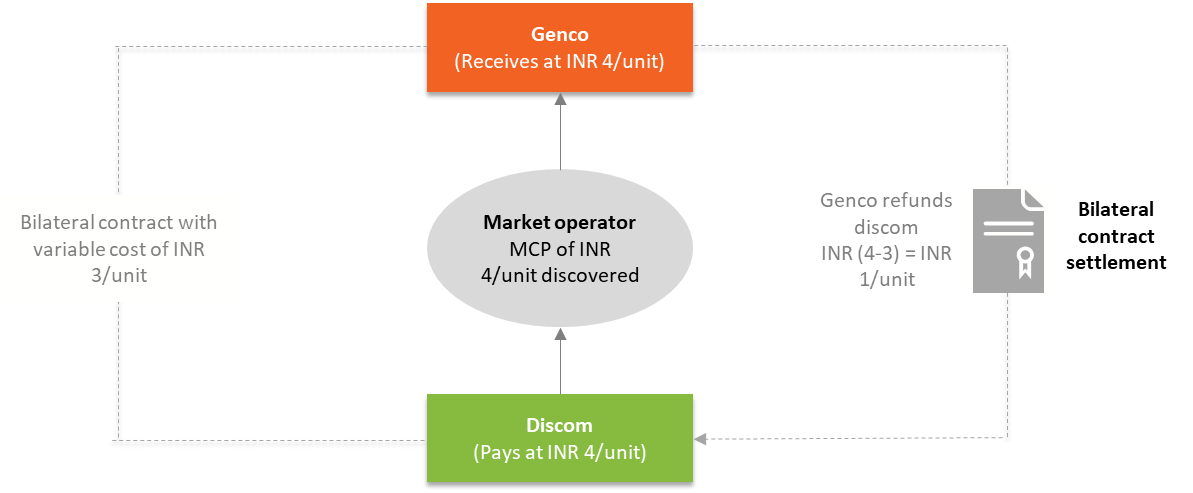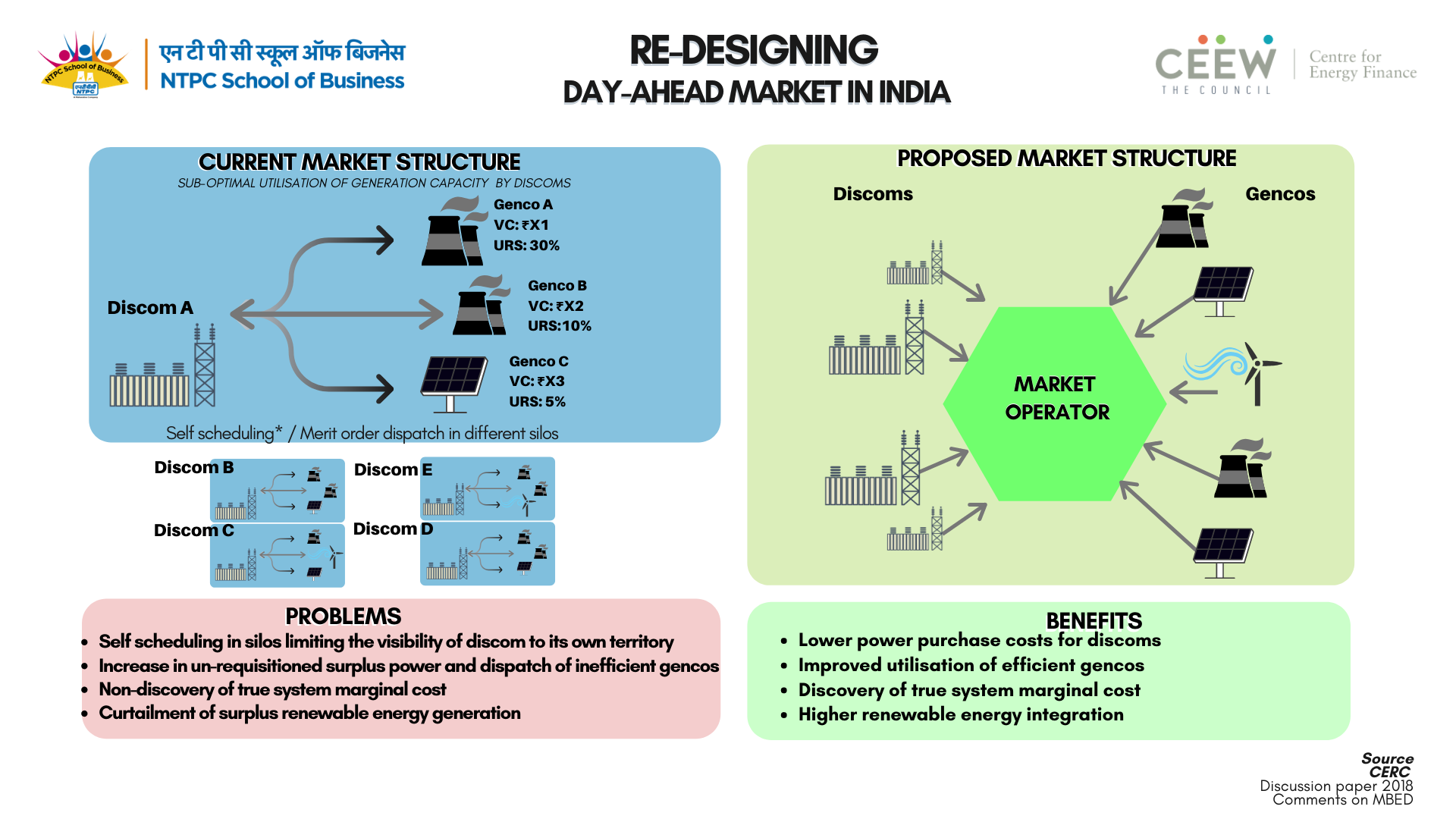Context
Electricity distribution companies (discoms) in India predominantly buy electricity from the wholesale power market under long-term (typically 25 years), medium-term (up to 5 years), and short-term (up to 1 year) contracts. A majority of their daily power demand is met through long-and-medium-term contracts, while the rest is met through bilateral transactions between discoms via traders or power exchanges1, 2. Though a discom buys capacity through contracts of varying durations, it schedules power supply only on a day-ahead basis. To balance possible mismatches between procurement and supply, the discom either buys additional power from the market or other discoms (if the demand is expected to increase) or sells or curtails the excess contracted capacity (if the demand is expected to decrease)3.
In the current mechanism, power generators (gencos) supply power to the discoms as per their contracts. The discoms schedule power based on their demand estimate and the available capacity for each 15-minute time block for the day ahead. This is called ‘self-scheduling’. However, demand and supply can fluctuate unexpectedly and across time blocks. To handle such real-time imbalances between demand and supply, mechanisms such as rescheduling, deviation settlement, and ancillary services are deployed.
Each of the 70+ discoms in the country schedule their required power with their respective contracted gencos. However, discoms are not obligated to disclose the cost (specifically, the variable cost) of their scheduled generation to the system operator. Interestingly, though there may be a genco offering its excess capacity at relatively low prices, this cheaper power may go underutilised as discoms are unaware of this availability. Given the financial distress of discoms, it is critical that we reduce such systemic inefficiencies.
In December 2018, the Central Electricity Regulatory Commission (CERC) published a discussion paper Market-based Economic Dispatch of Electricity: Re-Designing of Day-ahead Market (Dam) In India. The paper proposes a day-ahead market where discoms and gencos can make demand and supply bids based on variable costs to a centralised platform mediated by a market operator (power exchange). The objective is to dispatch the power that costs the least first by giving discoms the ability to source power from all gencos, as long as grid security is maintained.
The market operator will arrive at a market clearing price (MCP) by matching the last generators’ supply offer matched to meet the demand offers. The discoms would have to procure the required electricity from the market operator at the MCP, which, in turn, would be paid to the gencos supplying power. The settlement for fixed costs shall be outside the ambit of this market. Discoms shall pay the same to their contracted gencos based on the latter’s availability. However, if the MCP is higher than the contracted price (variable cost) a genco had agreed with a discom, then the genco will refund the excess to the discom. This ensures that the discom will not be forced to pay more for its contracted capacity. This mechanism, referred to as ‘bilateral contract settlement’, shall be applicable in cases where a bilateral contract already exists between a genco and a discom to ensure price hedging for the latter. A sample transaction has been explained below.
Figure 1: Transactions under market-based economic dispatch

Source: CEEW-CEF analysis
The CERC discussion paper also demonstrates how the demand of five states can be met at the lowest variable cost, yielding significant savings in overall system costs. The following infographic summarises key elements of the market-based economic dispatch (MBED).

Relevance and impact
The proposed market design is expected to have the following impact on the power sector:
Reduced power purchase costs
With a centralised pool of generation and demand offers, gencos will be forced to become more cost-efficient or shut down, thus lowering the overall variable cost of power in India.
Greater renewable energy integration
With power being scheduled and dispatched over a larger balancing zone, renewable energy is expected to be curtailed at a lower rate.
The key challenges envisaged in the implementation of an MBED are as follows:
- Discoms already facing a cash-flow deficit may face problems making upfront payments under this market mechanism unlike the existing mechanism of PPAs where payment is typically done 60–90 days after buying power.
- For gencos contracted competitively, that is, outside the ambit of CERC regulations, supplementary PPAs shall require approval by state regulatory commissions to enable MBED.
- Fuel supply contracts (domestic linkage or import-based) that have been signed keeping long-term PPAs in mind would need to be aligned in view of the new market mechanism.
- There would arise the need for tight market surveillance and monitoring to ensure efficient price formation and effective competition.
Who should care
- Distribution companies
- Power generators
- Power system operators (load despatch centres)
- Central and state regulatory commissions
- Power exchanges
This CEF Explains is part of the series of articles published in collaboration with NTPC School of business.
References
- [1] “Market Monitoring Report”, CERC, January 2020, http://www.cercind.gov.in/2020/market_monitoring/MMC%20Report%20January%202020.pdf
- [2] In January 2020, 10.41 per cent of the electricity was procured through bilateral contracts.
- [3] A discom is also a deemed ‘trading licensee’ as per the Electricity Act 2003 and can sell excess contracted capacity in power markets on days that the demand is lower than the contracted supply.
